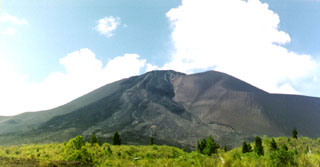Report on Soputan (Indonesia) — 11 February-17 February 2015
Smithsonian Institution / US Geological Survey
Weekly Volcanic Activity Report, 11 February-17 February 2015
Managing Editor: Sally Sennert.
Please cite this report as:
Global Volcanism Program, 2015. Report on Soputan (Indonesia) (Sennert, S, ed.). Weekly Volcanic Activity Report, 11 February-17 February 2015. Smithsonian Institution and US Geological Survey.
Soputan
Indonesia
1.112°N, 124.737°E; summit elev. 1785 m
All times are local (unless otherwise noted)
Based on information from PVMBG and weather models, the Darwin VAAC reported that during 11-12 February an eruption at Soputan generated ash plumes that rose to an altitude of 3.7 km (12,000 ft) a.s.l. and drifted almost 30 km SE. Ash was not identified in satellite images due to darkness and meteorological clouds.
Geological Summary. The Soputan stratovolcano on the southern rim of the Quaternary Tondano caldera on the northern arm of Sulawesi Island is one of Sulawesi's most active volcanoes. The youthful, largely unvegetated volcano is the only active cone in the Sempu-Soputan volcanic complex, which includes the Soputan caldera, Rindengan, and Manimporok (3.5 km ESE). Kawah Masem maar was formed in the W part of the caldera and contains a crater lake; sulfur has been extracted from fumarolic areas in the maar since 1938. Recent eruptions have originated at both the summit crater and Aeseput, a prominent NE-flank vent that formed in 1906 and was the source of intermittent major lava flows until 1924.

